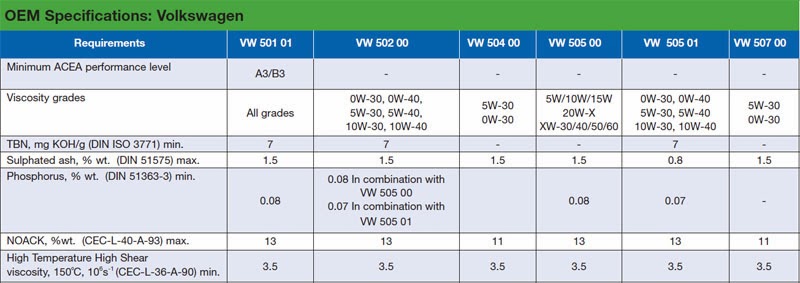Originally Posted By: edyvw
Originally Posted By: Gokhan
Originally Posted By: edyvw
Base stock? You have VW 504.00 that are mainly Group III and have 502.00 that are 100% PAO (Motul) or very high content of PAO (GC is not 100% combination of PAO and Ester).
M1 0W30 ESP is not VW504.00 compliant at all!
There is so much misinformation here.
M1 0W-30 ESP is VW 504 00 compliant: Reference
VW 504 00 specifies better base stock (11% NOACK) than VW 502 00 (13% NOACK): Reference (see page 146)
NOACK determines the base-stock quality for a given cold-start viscosity: Reference
Last but not least, actual base stocks used in an oil are neither known nor a certain base stock is required by an OEM/API/ACEA/ILSAC spec. OEMs/API/ACEA/ILSAC only specify the NOACK, not the base-stock type.
That is Mobil1 5W30 ESP NOT 0W30!
I have M1 5W30 ESP in my car now.
NOACK is important, but 11% is not very good value. MB 229.5 and 229.51 are much better reference.
Redline has NOACK of 6%, GC has below 10%, PU Euro 5W40 and L version should have below 10% because 5W40 meets MB 229.5 and L meets 229.51. And yes, base stock does not mean oil cannot meet OEM spec, and you have some very good GroupIII oils such as Pentosin or M1 0W40.
That was just a typo of course -- there is no such thing as Mobil 1 0W-30 ESP and Mobil 1 0W-30 AFE has an HTHS viscosity of only 3.0 cP (being a fuel-efficient oil) as opposed to 3.5 cP minimum of any VW spec (for more wear protection in more demanding driving conditions at the cost of fuel economy).
Yes, you can always have higher-quality base stocks, PAO and GTL being the highest quality. However, it's important to note that the NOACK comparisons should always be made taking the cold-cranking viscosity (CCS) into account. For a given base stock, if CCS gets higher, NOACK will get lower. You can't compare NOACK of 20W-50 to 0W-50 and claim that they use the same base stock. Likewise, certain oils for a given x of xW-** grade might have very low CCS (for better cold cranking), resulting in higher NOACK.
Also, usually some mix of base stocks is needed to overcome some negative attributes of a given base stock. For example PAO (Group IV) usually needs to be mixed with some Group V to overcome its certain undesired properties.
Originally Posted By: Gokhan
Originally Posted By: edyvw
Base stock? You have VW 504.00 that are mainly Group III and have 502.00 that are 100% PAO (Motul) or very high content of PAO (GC is not 100% combination of PAO and Ester).
M1 0W30 ESP is not VW504.00 compliant at all!
There is so much misinformation here.
M1 0W-30 ESP is VW 504 00 compliant: Reference
VW 504 00 specifies better base stock (11% NOACK) than VW 502 00 (13% NOACK): Reference (see page 146)
NOACK determines the base-stock quality for a given cold-start viscosity: Reference
Last but not least, actual base stocks used in an oil are neither known nor a certain base stock is required by an OEM/API/ACEA/ILSAC spec. OEMs/API/ACEA/ILSAC only specify the NOACK, not the base-stock type.
That is Mobil1 5W30 ESP NOT 0W30!
I have M1 5W30 ESP in my car now.
NOACK is important, but 11% is not very good value. MB 229.5 and 229.51 are much better reference.
Redline has NOACK of 6%, GC has below 10%, PU Euro 5W40 and L version should have below 10% because 5W40 meets MB 229.5 and L meets 229.51. And yes, base stock does not mean oil cannot meet OEM spec, and you have some very good GroupIII oils such as Pentosin or M1 0W40.
That was just a typo of course -- there is no such thing as Mobil 1 0W-30 ESP and Mobil 1 0W-30 AFE has an HTHS viscosity of only 3.0 cP (being a fuel-efficient oil) as opposed to 3.5 cP minimum of any VW spec (for more wear protection in more demanding driving conditions at the cost of fuel economy).
Yes, you can always have higher-quality base stocks, PAO and GTL being the highest quality. However, it's important to note that the NOACK comparisons should always be made taking the cold-cranking viscosity (CCS) into account. For a given base stock, if CCS gets higher, NOACK will get lower. You can't compare NOACK of 20W-50 to 0W-50 and claim that they use the same base stock. Likewise, certain oils for a given x of xW-** grade might have very low CCS (for better cold cranking), resulting in higher NOACK.
Also, usually some mix of base stocks is needed to overcome some negative attributes of a given base stock. For example PAO (Group IV) usually needs to be mixed with some Group V to overcome its certain undesired properties.


